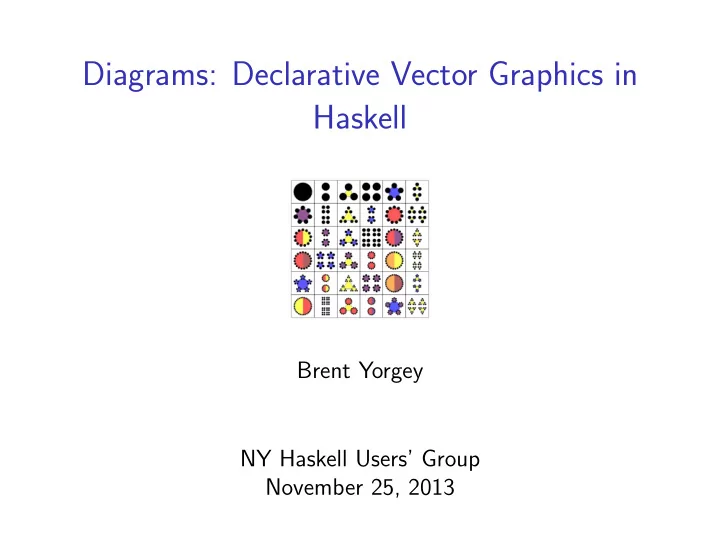

Diagrams: Declarative Vector Graphics in Haskell Brent Yorgey NY Haskell Users’ Group November 25, 2013
Part I: Demo!
Part II: Lessons for EDSL design
Take home Domain analysis is hard!
Take home Domain analysis is hard! Be in it for the long haul.
History
April 2008. Wanted: declarative, programmatic drawing.
PGF/TikZ
“How hard could it be?”
After two weeks of feverish hacking, diagrams was born!
After two weeks of feverish hacking, diagrams was born! It sucked.
Paths
What is a path ?
type Path = [ Point ]
Problem 1 ?
Problem 2 type Path = [( P2 , CurveSpec )] ?
Affine spaces
Find the bug type Point = ( Double , Double ) type Vector = ( Double , Double ) instance (Num a , Num b ) ⇒ Num ( a , b ) where . . . parallelogram :: Point → Point → Point → Point parallelogram p 1 p 2 p 3 = p 1 − p 3 − p 2
Affine spaces for programmers Confusing points and vectors is a type error!
Affine spaces
translate ( p 1 − p 2 ) ≡ translate p 1 − translate p 2
translate ( p 1 − p 2 ) ≡ translate p 1 − translate p 2 Translations apply to points but not to vectors!
(ˆ + ˆ) :: Vector → Vector → Vector ( . + ˆ) :: Point → Vector → Point ( . − . ) :: Point → Point → Vector
. . . Paths Again
type Path = [ Vector ]
type Path = [ Segment ]
type Path = ([ Segment ] , Bool) ?
( , True )?
( , True )?
Our solution data Offset c v where OffsetOpen :: Offset Open v OffsetClosed :: v → Offset Closed v data Segment c v = Linear ( Offset c v ) | Cubic v v ( Offset c v )
data Trail ′ l v where Line :: [ Segment Closed v ] → Trail ′ Line v Loop :: [ Segment Closed v ] → Segment Open v → Trail ′ Loop v glueLine :: Trail ′ Line v → Trail ′ Loop v closeLine :: Trail ′ Line v → Trail ′ Loop v :: Trail ′ Loop v → Trail ′ Line v cutLine
Problem 3
Problem 3 type Trail = [ Segment ] . . . type Path = [( Point , Trail )]
Our solution data Located a = Loc { loc :: Point ( V a ) , unLoc :: a } newtype Path v = Path [ Located ( Trail v )]
Recommend
More recommend